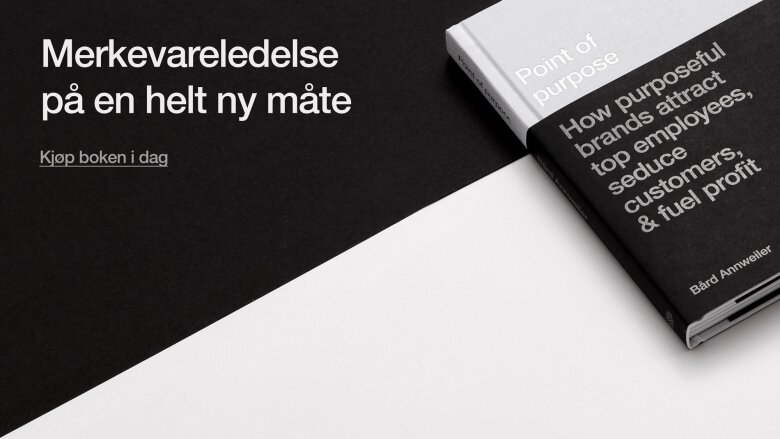How do you distinguish purpose from branding?
Some companies get by without a relevant purpose to build on. But the figures speak for themselves: there’s every chance they’d do even better with a purpose. A great purpose statement that beautifully sets out exactly why your company exists is worth so much less if you’re unable to use it and implement it in the day-to-day workings of your company and the branding of your company.
One of the best companies at doing this is Swedish. Ingvar Kamprad, founder of IKEA, came up with the company’s inspiring statement back in 1976: To create a better everyday life for the many people. This statement works just as well today as it did when it was devised, and it speaks directly to everyone involved or interested in IKEA in one way or another. IKEA has stuck to this old recipe for success for more than 40 years, and you could say they’ve done relatively well in this time. Forbes ranks IKEA as the 46th most valuable brand in the world in 2018.
The customer first, says IKEA. The Swedish furniture giant appears as a down-to-earth counterbalance to the more refined and exclusive part of the furniture industry. The flat-packing and cost-cutting that IKEA prides itself on implementing, signal that here most people can have a better everyday life because a number of things for the house have become available at a livable price. Price is always central when IKEA presents a product, but it rarely stands alone. At IKEA, they sell big dreams at cheap prices, so that absolutely everyone who wants it has the opportunity to stretch a little further than the economy would dictate. Their business idea reads as follows: "Our business idea is to offer a wide range of well-designed, functional home furnishing products at prices so low that as many people as possible will be able to afford them” . In other words: create a better everyday life for the masses. They strive to get the highest possible quality for the lowest possible price by optimizing the entire value chain, creating long-term partnerships with suppliers, automating and producing in large volumes. They also use the purpose as a guideline when talking about sustainability. According to their own pages, IKEA's main financial principle is to grow by using their own resources, that is, to make money before they spend them. This enables them to make long-term investments that can last far into the future. They invest most of their income in existing and new IKEA stores, and, according to themselves, in product development, sustainable solutions and continuously pushing prices as far down as possible. IKEA's purpose lives in symbiosis with brand building. But new companies are coming up with a new type of brand that is revolutionizing the landscape.
Below, we’ll look at a number of Nordic companies that we think have a meaningful purpose that can be implemented on a day-to-day basis. A positive bonus effect occurs when a purpose is so clear and user-friendly that traces of the thought behind the purpose manifest themselves physically; in shops, at meeting places, in marketing and advertising, in press statements, prior to recruitment and – not least – among the people we meet who work there.
There are plenty of good reasons as to why you should have a meaningful purpose. The purpose can act as a yardstick, a memo, a signal, a principle, an explanation, a program statement, a soul, an ambition level, a tag, a hook, an ideal, a fantasy, a content source and more. We ourselves have defined the fact that a purpose is why we do what we do. The thing that shows why you run a business, that factor that’s even more important than earning money. This could be a “hairy” objective demonstrating your motivation and what you want to achieve here in the world – and usually what you want to do for the world as well.
Nordic brands with purpose
Hydro
One of the Norwegian exceptions that confirm the rule is Hydro. Their purpose is “Our purpose is to create a more viable society through effective, innovative development of natural resources and products”. In The Hydro Way, Hydro expand upon their this as follows: “All companies have to be profitable. But if they are truly to make a difference, they have to have a higher purpose as well. Our purpose sets the standard that we as a company and our staff try to live up to every day. Certainly, our purpose includes a truly enormous element, but it also indicates a number of fairly down-to-earth, everyday ambitions that have consequences for all of us. By making our purpose normative for the decisions, great and small, that we make every single day, we can actually make the world around us more viable.” After that, they go on to refer to the importance of their talents and values.
Hydro has devised a well thought out, readily accessible document, and it shows what’s important to them in an uncomplicated way. Hopefully, we’re involved with an organisation that takes its own purpose seriously. When Hydro took over three bauxite mines in Brazil in 2011, this was because this substance is needed to make aluminium. At the same time, it was a controversial decision to make because we’re talking removing 100 football pitches-worth of rainforest each year that have taken millions of years to develop their present biodiversity. For this reason, Hydro have undertaken to attempt to replant rainforest in all the areas where they extract bauxite. The aim is to cultivate 300,000 seedlings a year there, so we can only hope that they do actually follow up on their commitments in this regard. And that this is something they’re doing because they want to try to atone for some of the impact they’ve had on nature, and not just because they’re contracted to do so.
One area where Hydro has embraced its “effective, innovative development of natural resources and products” is in connection with tealights. Hydro supplies 3000 tonnes of aluminium for tealight containers every year. In Norway, we light 200 million of these tiny and popular light sources every year. If these were recycled properly, they could be transformed into 30,000 new bikes. Aluminium is easy to recycle, so recycling these containers is extremely valuable. The Telysjakten – Hunt for Tealights – campaign was launched for Year 1 to Year 4 pupils all over the country in partnership with IKEA, WWF, Grønt punkt and Syklus. A total of 12 million used tealights were collected, providing enough aluminium to build 2000 bikes. This was an extremely popular competition among the 26,000 pupils who took part, not because, but perhaps more despite (?) the fact that the first prize awarded to the class that collected the most was a trip to the Hydro aluminium plant in Holmestrand.
Narvesen
Narvesen’s purpose is: We will be a bright spot in people’s day-to-day lives. When Narvesen became a customer of Mission, the matter of the company’s purpose was also put on the table. When we looked more closely at the statement that they themselves had developed and used internally, we all agreed that they actually had a purpose statement that worked really well. Rather, the question was what else Narvesen could be doing to implement this message in specific actions and choices.
Mission has helped Norway’s biggest kiosk chain with measures that reinforce the chain as a bright spot . We’re behind extensive modernisation of the Narvesen identity , the first major rebranding operation in 25 years, and this includes making their shops brighter and more pleasant places to be. The redesign includes a light path in the ceiling to encourage seamless movement through the shop area. We’ve also developed a system that significantly simplifies the time customers spend in the shop. The busiest customers can get what they need at the speed of light and sprint onwards, while people with plenty of time to spare can hang around in the book and magazine department without getting in the way of the main group – typical customers. This way of differentiating between various users means that even more people enjoy their little visits to Narvesen. That’s part of the purpose. People should feel that little bit brighter when they’ve been to Narvesen.
Nordic Choice Hotels
Their purpose: We are creating a better world with Energy, Guts and Enthusiasm. WeCare! Nordic Choice Hotels preaches and serves up eco-friendly options, they provide healthy breakfasts that are even lit so that they look great on Facebook and other social media. One small special elements in the case of Choice is that when we hear their purpose, we usually think of the owner, Petter Stordalen – it’s not always all that easy to distinguish him from his company. Energy, Guts and Enthusiasm are undoubtedly labels that many people would apply to him, and they’re definitely qualities that are high on the list when the organisation takes on new staff. At the same time, their purpose will also allow them to continue even when Stordalen sets aside the captaincy at some point in the future – an important factor when developing a purpose for the future.
Further six Nordic purpose brands
Hurtigruten . We will offer secure, unique, active and sustainable experiences that create memories.
Mills . Our primary task is to make it easy for current and future generations to gather together around good, healthy food.
SAS . Makes your travel easier.
Nokia . We are shaping the future of technology to transform the human experience.
Volvo . Our purpose is to provide safe, sustainable and convenient mobility, making a positive contribution to society.
Five reasons why your brand benefit from purpose
Working with identity gives you a guiding light . Whether you’re working on the visuals or the choice of words in a press release, the company’s purpose should inspire the option you choose.
When you know who you are, you know what you should do New products or services? Mergers or company takeovers? Appointments or layoffs? Marketing and advertising? Controversial choices? The company’s purpose may be the litmus test that prevents the management, employees and investors making poor decisions for the company.
When you know what means something to the company, it’s easier to work out who you should help. What charity or activities should the company support? Ball pits and/or company revues? Picking up plastic and/or trips for pensioners? The wording of a purpose can hint at what initiatives will be in line with the company.
Unnecessary discussions are avoided when something is rock solid . It’s easier to control, guide or communicate with everything from architects and web designers to press officers and journalists when you operate with a purpose that can’t be adjusted or adapted to sitting with short-term objectives.
Things move more quickly when you have a collective platform. In larger organisations, people need something to agree on. Busy people need a message that goes straight to the heart of the matter. Both new staff and part-time staff must be able to understand instantly what constitutes the soul of the company.




